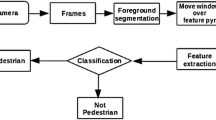Abstract
The active events recognition is the essential part of surveillance systems. In such systems, the statistical training methods are very popular. In this research, the Robust for Noises Boost (RONBoost) algorithm is proposed. It is based on the classifying cascades and was tested on various scenarios of pedestrian behavior in the outdoor scenes. The satisfactory results were achieved not only by the RONBoost algorithm implementation but also the object capture and tracking based on the spatiotemporal filtering and the motion segmentation using the analysis of tensor structures. The error of motion segmentation was decreased to 4 %. The experiments demonstrate the satisfactory results: the deviation of moving regions is less 10 % and the classification error is around 2–5 %. For video sequences with worse luminance conditions, this error is increased up to 7–10 %.
Access this chapter
Tax calculation will be finalised at checkout
Purchases are for personal use only
Similar content being viewed by others
References
Galar M, Fernández A, Barrenechea E, Bustince H, Herrera F (2012) A review on ensembles for the class imbalance problem: bagging-, boosting-, and hybrid- based approaches. IEEE Trans Syst Man Cybern Part C Appl Rev 42(4):463–484
Breiman L (1996) Bagging predictors. Mach Learn 24(2):123–140
Freund Y, Schapire RE (1997) A decision-theoretic generalization of on-line learning and an application to boosting. J Comput Syst Sci 55(1):119–139
Oza NC (2004) Aveboost2: boosting for noisy data. In: Roli F, Kittler J, Windeatt T (eds) Multiple classifier systems. LNCS 3077, Springer, Berlin, pp 31–40
Karmaker A, Kwek S (2006) A boosting approach to remove class label noise. Int J Hybrid Intell Syst Hybrid Intell Syst Ensembles 3(3):169–177
Rasolzadeh B, Petersson L, Pettersson N (2006) Response binning: improved weak classifiers for boosting. In: Proceedings of 2006 IEEE intelligent vehicle symposium (IVC 2006). Tokyo, Japan, pp 344–349
Schapire RE, Singer Y (1999) Improved boosting using confidence-rated predictions. Mach Learn 37(3):297–336
Friedman J, Hastie T, Tibshirani R (2000) Additive logistic regression: a statistical view of boosting. Ann Stat 38(2):337–374
Sochman J, Matas J (2005) Waldboost—learning for time constrained sequential detection. In: Proceedings of IEEE computer society conference on computer vision and pattern recognition (CVPR 2005), vol 2. San Diego, CA, USA, pp 150–156
Seiffert C, Khoshgoftaar T, Van Hulse J, Napolitano A (2010) RUSBoost: a hybrid approach to alleviating class imbalance. IEEE Trans Syst Man Cybern Part A Syst Humans 40(1):185–197
Chawla NV, Bowyer KW, Hall LO, Kegelmeyer WP (2002) SMOTE: synthetic minority over-sampling technique. J Artif Intell Res 16(1):321–357
Liu XY, Wu J, Zhou ZH (2009) Exploratory undersampling for class-imbalance learning. IEEE Trans Syst Man Cybern B Cybern 39(2):539–550
Galar M, Fernández A, Barrenechea E, Herrera F (2013) EUSBoost: enhancing ensembles for highly imbalanced data-sets by evolutionary undersampling. Pattern Recogn 46(12):3460–3471
Ibarra-Manzano MA, Almanza-Ojeda DL (2012) An FPGA implementation for image interpretation based on adaptive boosting algorithm in the real-time systems. Procedia Technol 3:187–195
Kim TK, Cipolla R (2013) Multiple classifier boosting and tree-structured classifiers. In: Cipolla R, Battiato S, Farinella GM (eds) Machine learning for computer vision. Springer, Berlin, SCI 411, pp 163–196
Author information
Authors and Affiliations
Corresponding author
Editor information
Editors and Affiliations
Rights and permissions
Copyright information
© 2016 Springer International Publishing Switzerland
About this paper
Cite this paper
Favorskaya, M., Jain, L.C. (2016). Recognition of Pedestrian Active Events by Robust to Noises Boost Algorithm. In: Balas, V., Jain, L., Kovačević, B. (eds) Soft Computing Applications. Advances in Intelligent Systems and Computing, vol 357. Springer, Cham. https://doi.org/10.1007/978-3-319-18416-6_68
Download citation
DOI: https://doi.org/10.1007/978-3-319-18416-6_68
Published:
Publisher Name: Springer, Cham
Print ISBN: 978-3-319-18415-9
Online ISBN: 978-3-319-18416-6
eBook Packages: EngineeringEngineering (R0)




